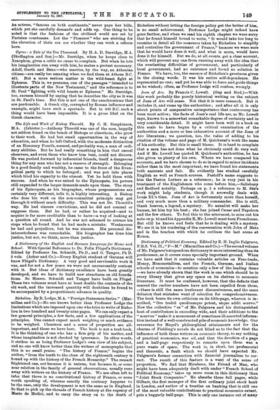Joan of Arc. By Francis C. Lowell. (Gay and Bird.)—With
this work probably the purely historical writing on the subject of Joan of Arc will cease. Not that it is mere research. But it includes it, and sums up the authorities ; and after all it is only about points of comparative unimportance that controversy has been most active ; the facts of Joan's real life are, as Mr. Lowell says, known to a somewhat remarkable degree of certainty and in very considerable detail. It might have been well in a book on this scale to have begun by a critical examination of the authorities and a more or leas exhaustive account of the Joan of Arc literature ; we question, too, the value of adding to his citation of the volume and page of M. Quicherat's work the name of his authority. But this is small blame. It is hard to complain that a man has not done what he obviously could do very well. And if Mr. Lowell has quoted M. Quicherat's authorities, he has also given us plenty of his own. Where we have compared his accounts, and we have chosen to do so in regard to minor incidents rather than in the most important, we have found his statements both accurate and fair. He evidently has studied carefully English as well as French sources. Fastolf's name suggests to him the Pesten Letters as a reference; he is very just in his treatment of the Englishmen who come before him,—Salisbury and Bedford notably. Perhaps on p. 2 a reference to M. Sie's work might help students, though it avowedly deals with Louis XI.'s time. Joan of Arc is fortunately more than herself, and very much more than a military commander. She is still, thank heaven, a legend, a mystery. No annalist will make her human, let him try his best ; she has joined Ca3sar and Napoleon and the few others. To feel this to the uttermost, to miss out his note on p.45 and his Appendix B, Mr. Lowell must turn Frenchman. But still he knows and feels that he is dealing with a mystery. We see it in his rendering of the conversation with John of Metz and in the touches with which he outlines the last scene at Rouen.


















































 Previous page
Previous page